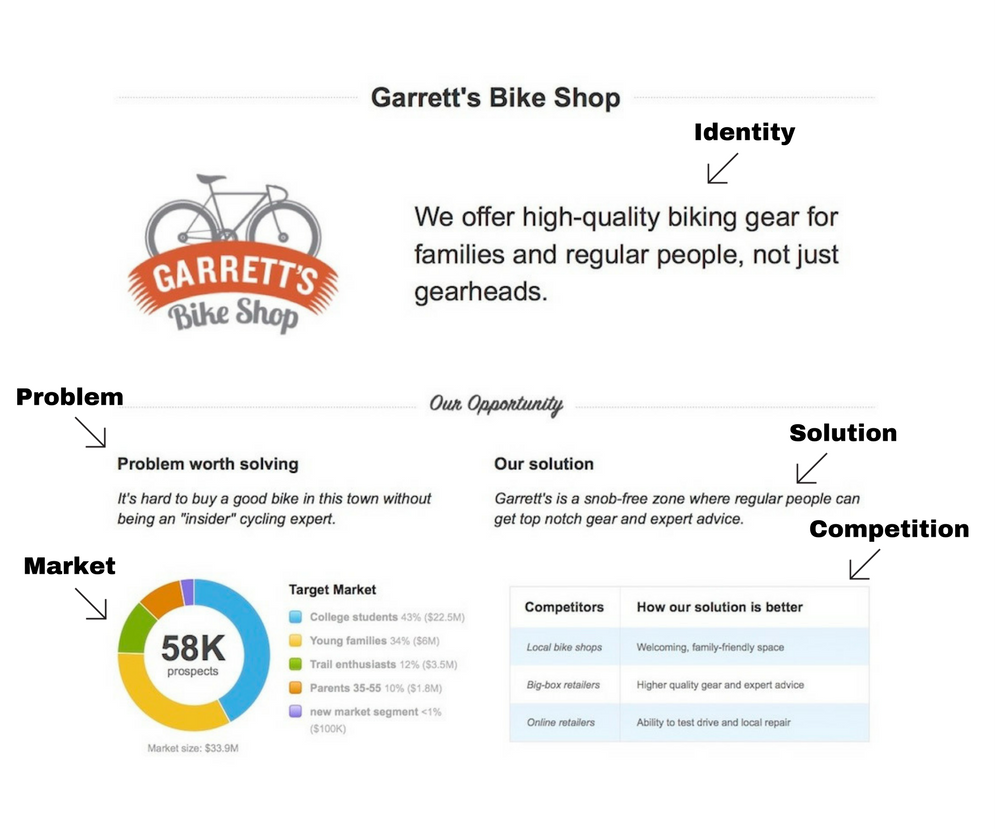How to Build a Winning Business Strategy in 5 Steps
Posted By

Tim Berry, the founder of Palo Alto Software and one of my mentors, always says, “Strategy is focus. A good strategy is all about the opportunities that you decide not to pursue.”
This has been great advice for me over the years. I’m always flooded with new—and seemingly good—ideas for things that we could do to grow our company. There are always new potential partnership opportunities, new feature ideas, and new marketing concepts to try.
But, not all shiny new ideas should be implemented. And, with limited resources, you can only do so much.
That’s why having a solid business strategy has been invaluable. Having decided on a strategy for growth, we’re able to stay focused and avoid distractions as we work towards achieving our goals. And you can do the same.
What is a business strategy?
A business strategy defines what a business does and how it does it. It explains the problem the business solves for its target customers and what its unique value proposition is. In other words, a business strategy describes how a business differentiates itself from its competitors and stands out in the marketplace.
For example, a fast food restaurant may have a strategy to only serve fresh, organic ingredients that were never frozen. The goal is to reach customers who would otherwise typically avoid fast-food restaurants.
A clothing manufacturer’s strategy could be to use only local suppliers and manufacturing. By producing a superior product they can position themselves against fast fashion alternatives that are cheaply manufactured overseas.
A business strategy is different from tactics. While your strategy defines what you do and what your secret sauce is, tactics are the specific things you are going to do to achieve your strategy. For example, our fast food restaurant’s tactics would include setting up a supply chain for organic ingredients. Our clothing manufacturer’s tactics will include establishing contracts with local cloth suppliers.
Why you need a strategy
Unfortunately, too many businesses get started without really knowing what their strategy is. Some businesses get lucky and hit on a successful strategy right away, but the majority of businesses don’t get it right on the first try, which leads to wasted time, money, and potential business failure.
A good strategy defines your business and helps you grow. It represents who you are and informs virtually every day-to-day decision that you will make in your business. More importantly, it helps keep you and your employees focused on your goals and mission.
Without a strategy, you can end up pursuing every new opportunity that comes your way—instead of focusing on the opportunities that help you achieve your goals.
Documenting your business strategy is also vital to the fundraising process. Investors will want to know what your strategy is and how your approach to solving a problem for customers is unique in the marketplace.
How to build your business strategy
Developing your business strategy doesn’t have to be hard. Here are five steps to help you discover and document your business strategy:
1. Define your business identity
Your identity is the key value proposition to your customers. Your identity should be no more than one sentence and simply declare the value that you provide.
For example, a bike shop’s identity might be—“We offer high-quality bike gear for families and regular people, not just gearheads.”
A good business identity describes what you do and who you do it for. Think of how you’d answer the “What do you do?” question at a dinner party and you’re going to be pretty close to what your business identity is.
2. Describe the problem you are solving for your customers
You should be able to define the problem you are solving in one or two sentences or a few bullets.
For our bike shop example, here’s the problem they’re solving: “Most bike shops in this town are focused on racing and high-end enthusiasts. There’s no good option for affordable bikes used by commuters and families.”
3. Explain how your solution solves your customers’ problem
This is essentially a brief description of your product or service.
Our bike shop’s solution: “We sell affordable bikes to families and bike commuters, all without the intimidation and attitude of the higher-end bike shops.”
4. Define your target market and ideal customer
Describe your ideal customer in a few bullets. You may want to think about the size of each of your market segments at this stage to make sure you have enough potential customers to build a sustainable business. In-depth market research isn’t always necessary, but you do want to have a good sense of who your target customers are.
For our bike shop example, the target might be families, college students, and bike commuters.
5. Describe your competition and your key differentiators
Just list your top competitors and a brief sentence or phrase about how you are different or better.
If you use LivePlan, you can build your strategy using the Pitch feature. It creates the format for your strategy, walks you through each step, and presents it as an easy-to-read page you can share with business partners. You can also download our free one-page plan template and develop it on your own.

For new businesses, your business strategy is really your best guess at what you think might work. You’re guessing that your target market has the problem you assume they have and that they’re going to be interested in your solution. In the next section of this post, we’ll explore how to determine if your strategy will work.
For established businesses, you can use this five-step format to document your strategy to easily share it with your team, potential investors, and other stakeholders in your business.
How do you know if you have a business strategy that works?
Now that you’ve written down your assumptions about your business strategy, you need to find out if you’re on the right track and actually have a good strategy. You’ll do this before you even think about spending money growing your business. This will reduce your risk and help ensure that your business is going to be a success.
After all, your assumptions might be wrong, so now’s the ideal time to figure this out and make changes to your business strategy if necessary. It’s a lot cheaper and easier to do this early in the process than once your business is up and running, and you’ve invested significant time and money in a strategy that might not be working.
It’s easy to change strategies when you don’t have employees, a real office or storefront, and other supplies and equipment. Once you have all those things, a significant change in strategy can be disruptive and expensive.
To figure out if you’re on the right track with your business strategy, go out and talk to people in your target market:
- Interview them and find out if they actually have the problem that you think they have. Be sure to ask open-ended questions and try not to lead them toward specific answers.
- Find out if they like your solution.
- Try and figure out what they think your solution is worth—what are they willing to pay for your products and services?
After you talk to your potential customers, there’s a very good chance that you’re going to have to go back and revise your initial strategy. You might revise your solution or potentially adjust your target market.
Don’t worry if it takes several rounds of interviews and refinements to your strategy to get it right. That’s normal. You’ll also be greatly increasing your chances of success because you’re making sure that you’re selling something that your customers actually want to buy.
The information you collect in your customer interviews will also drive the next step in the process of developing a one-page business plan—developing your marketing and sales tactics. Your strategy outlines what you’re going to do and your tactics will outline how you’re going to do it.
How to put your strategy into action
To turn your strategy into a tool that will help grow your business, you need to incorporate it into your business management toolkit. To help you with this, we’ve developed a process called growth planning to help you create a better, smarter business—all while reducing your risk and increasing your chances of success.
In a nutshell, you’ll use growth planning to develop a business strategy significantly faster than any traditional method (like, in 30-minutes-fast), and then test that strategy in the real world so you can make sure you have a bulletproof idea before you spend a bunch of time and money getting your business started. Growth planning is a process that helps you perfect your idea, not just another way to write a business plan.
You can read more about the entire growth planning process here if you want more background on the system.
